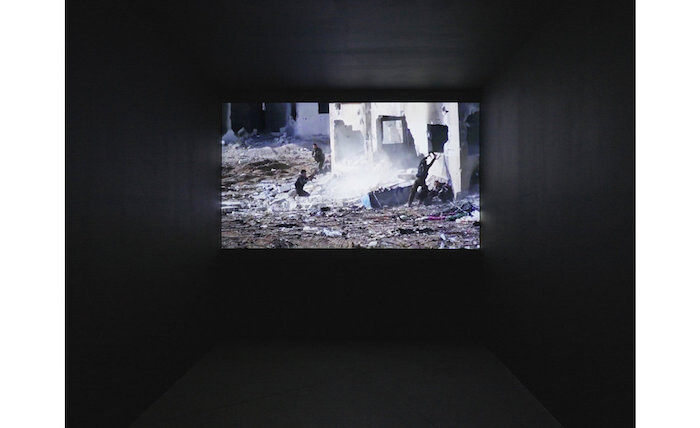Six years in, Syria’s Civil War has been the subject of a vast quantity of information—in the form of user-generated video, reportage, news analysis, social media updates—and yet we seem no nearer to an adequate means of representing it. Representation and resolution are often intertwined: the clarity of a representation, the point at which visual material resolves into an image, is a question of the way in which content is subjected to form. We are still seeking a form with which to organize the barrage of information from Syria into a coherent image that will make the conflict materially sensible for those only able to apprehend it from afar.
Documentary media have historically been the privileged modes through which to process such crises. News reportage now constitutes the most prolific of these, if also the noisiest. But contemporary art, with its recently intensifying interest in strategies of documentary, has been quick to respond as well: through photography and reenactment—such as Ai Weiwei’s restaging of the shocking photograph of Alan Kurdi, the Syrian toddler who drowned off the coast of Turkey, with the artist himself as the dead child—as well as more “archival,” object-based exhibitions of work made by Syrian artists or migrants. Meanwhile, documentary cinema—including films such as Silvered Water, Syria Self-Portrait (2014), Our Terrible Country (2014), and, most recently, Last Men in Aleppo (2017)—has arguably been more effective, at least in its ability to represent a set of distances: between Syria and the West, the conflict and its spectators, the real and its representation.
Now showing at Marian Goodman, New York, Dara Birnbaum’s video installation Psalm 29(30) (2016) lies somewhere in between these modes. Made in collaboration with Michael Saia, who edited the work, and scored by two works by the composer Neil Benezra, the installation comprises six channels of video that contrast original high-definition video images of placid European landscapes (specifically, Lake Como and the Italian Alps) with found low-resolution video images of violent conflict. Five of these channels, each with its own flatscreen, express this contrast through montage and superimposition. Picture-postcard depictions of Romantic vistas are interrupted by brief glimpses of cellphone imagery: diaphanous fog becomes dust and smoke; glorious sunsets, explosions, and gunfire. A sixth channel—projected inside a black-box enclosure which the gallery’s introductory text refers to as a “heart-chamber”—presents the images that, outside, could only tenuously impose themselves: fuzzy pictures taken by combatants at the center of the conflict, firing rifles through holes, ducking around corners in order to flee tanks and enemy gangs.
Amid the works’ many contrasts, the most striking is that between the textures of the original and the appropriated imagery: the exquisitely framed versus the handheld; the HD versus the compressed; the flat, timeless, and generic versus the textured, immediate, and highly specific. These contrasts recall the ways in which Birnbaum’s work with appropriated imagery has functioned throughout her career: as a means of making material and sensible a set of ambivalences. Her most iconic works—such as the set of videos she made between 1978 and 1983 using footage pilfered from television shows including Wonder Woman, Kojak, and PM Magazine—took up a paradoxical position between sexy video-promo allure and trenchant media critique. These works did not merely translate, simulate, or echo television’s imagery in new forms—as did that of Richard Prince, Cindy Sherman, and other Pictures Generation contemporaries—but engaged the hybrid apparatus of television itself: the media of the video signal and tape, as well as the television set and all of the tools employed in the industry to process it.
For Birnbaum, emphasizing the materiality of media technologies has served as an important means of emphasizing the way in which video art is both a collaborator and a critic of the industries of commercial image-making. The installation of her early works—such as the exhibition of her 1978 video Technology/Transformation: Wonder Woman in a hair salon in New York’s Soho, or her Documenta 7 installation of PM Magazine/Acid Rock (1982) in a setting constructed out of the same Speed-Rail frame system commonly used in television studios—foregrounds rather than obscures video’s complicity with the media industry. Media images, in Birnbaum’s work, are not simply objects of critique or the diaphanous tentacles of ideology, but materially ingrained in everyday life.
Consciously or not, Psalm 29(30) too materializes a set of uncomfortable facts about contemporary art’s effort to represent the crisis of Syria. In those images filmed during Birnbaum’s residency at the Rockefeller Foundation’s Bellagio Center on Lake Como, it materializes the art world’s systems of financial support: systems that are often structured around and situated in Western centers of cultural heritage and dependent on philanthropic capital. It also materializes the guilt inherent in this position for artists as well as institutions, a guilt that can only be felt as contrast or distance between nations, or classes, or ways of life. In this sense, Psalm 29(30) materializes an illusion of distance, whereas it should be materializing complicity.







